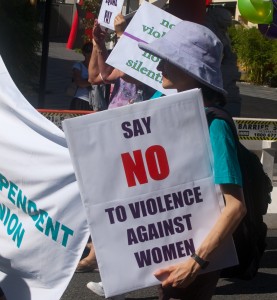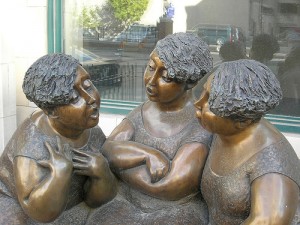The Woman Who Didn't Take No for an Answer–Not even from Jesus
I noticed that the Gospel Reading in the lectionary for this week is the story of the Syro-Phoenician woman in Matthew 15. A lot pastors have problems preaching this passage, so here is some help from What You Didn’t Learn in Sunday School: Women Who Didn’t Shut Up & Sit Down.
The Syro-Phoenician Woman didn’t shut up and sit down, even when Jesus told her too! I think you learn the most from this passage by comparing and contrasting it to the parallel passage in Mark.
The Syro-Phoenician Woman:
One Story, Two Gospels, Two Interpretations
Mark’s Story
From there he set out and went away to the region of Tyre. He entered a house and did not want anyone to know he was there. Yet he could not escape notice, but a woman whose little daughter had an unclean spirit immediately heard about him, and she came and bowed down at his feet. Now the woman was a Gentile, of Syrophoenician origin. She begged him to cast the demon out of her daughter. He said to her, “Let the children be fed first, for it is not fair to take the children’s food and throw it to the dogs.” But she answered him, “Sir, even the dogs under the table eat the children’s crumbs.” Then he said to her, “For saying that, you may go—the demon has left your daughter.” So she went home, found the child lying on the bed, and the demon gone (Mark 7:24-30, NRSV).
We don’t hear much about women giving Jesus lip in our churches. In the biblical witness we find two women who talked back to Jesus: Martha, the sister of Mary and Lazarus, and the Syro-Phoenician Woman in this passage. That these two women stood up to Jesus and talked back is usually explained away. In one scene, Martha was tired from cooking; in the other, her brother had just died: of course she’s snippy and Jesus is patient. In this scene, the Gentile woman knows that Jesus is just teasing her, and she plays along.
Martha and this woman’s backbones are covered up, their nerve shoved into a corner. Neither of these women thought silence and submission was the way to go.
Jesus had been healing and teaching. He fed the multitude of 5,000. He had been debating (fighting) with the religious leaders. He came to a totally pagan, Gentile area to get away from everything. He was here for a break. He was here to not teach, to not heal, to not fight. No one knew him here. He could sneak in, get some rest, and sneak out again. Or so he thought. Since Jesus was trying to stay incognito, we don’t how the woman knew he was in the neighborhood. My guess is the local grapevine. She found out a great healer was in town, and she decided to act. If she had a husband, he’s not mentioned. This mother acted on her own. She went to the house where Jesus was keeping a low profile, and there she fell at his feet begging him to heal her daughter, who was demon-possessed.
We expect Jesus to immediately act. We expect him to get up and go with this woman to her daughter, like he did with Jairus in the previous chapter. We also know from chapter 5 Jesus has no qualms about healing Gentiles: he healed the Gentile demoniac in the country of the Gerasenes. His first healing in Mark was healing a man with leprosy by touching him. But what we expect does not happen in this story.
Instead he told the woman, “it’s not right to throw the children’s bread to the dogs.” At this point (if we are honest with ourselves) our jaws drop, and we wonder “What happened to Jesus?”
A dog. Jesus called her a dog, a term of derision for Gentiles. They were unclean just as dogs were unclean. But pigs were unclean too, as well as graveyards, and Jesus did not call the Gerasenes demoniac a dog or swine. Why this abrupt change in Jesus? Does exhaustion alone account for it?
But the woman is quick-witted. She let the insult slide over her with this incisive retort: “Yes, but even the dogs get to lick up the crumbs on the floor.” Fine. If he called her a dog then a dog she would be. She accepted what dogs accept: table scraps, crumbs, whatever those at the table deem worthy enough or inconsequential enough to give.
Because this woman did not shut up (or submit to the Son of Godde), because she stood her ground, Jesus changed his mind. He had not come here to heal. He didn’t want to heal this woman’s daughter. But in the end he did heal the daughter. He did because of the woman’s retort. This woman’s daughter was healed because she talked back to Jesus, and didn’t assume her place was one of quiet submission.
Matthew’s Story
Jesus left that place and went away to the district of Tyre and Sidon. Just then a Canaanite woman from that region came out and started shouting, “Have mercy on me, Lord, Son of David; my daughter is tormented by a demon.” But he did not answer her at all. And his disciples came and urged him, saying, “Send her away, for she keeps shouting after us.” He answered, “I was sent only to the lost sheep of the house of Israel.” But she came and knelt before him, saying, “Lord, help me.” He answered, “It is not fair to take the children’s food and throw it to the dogs.” She said, “Yes, Lord, yet even the dogs eat the crumbs that fall from their masters’ table.” Then Jesus answered her, “Woman, great is your faith! Let it be done for you as you wish.” And her daughter was healed instantly (Matthew 15:21-28, NRSV).
We can interpret Matthew’s version of the story a little differently than Mark’s version. This is the main reason it’s hard to say this is what Godde meant one time and forever more. The writers of the Bible gave different versions of stories with their own interpretations and for application for their own communities. In Mark’s version the disciples are invisible; in fact, they’re not even mentioned. But not in Matthew: here they are front and center. I always figured it’s because Matthew was uncomfortable with the Jesus in Mark being abrupt and rude (Matthew and Luke “fix” Mark quite a bit). But an Anglican priest I met in 2009 gave me another way to interpret this story.
Reverend Nadim Nassar grew up in Syria and went to school in Lebanon. He now lives in London. There is a very cultural thing he grew up with that explains perfectly what is going on in Matthew if we know Middle Eastern culture. In the Middle East when the eldest son marries, he still lives at home with his parents, and his wife comes to live with the family. This is because as the main heir, the eldest son is expected to take care of his parents in their old age.
When the mother-in-law doesn’t like something the daughter-in-law is doing, or doesn’t think the daughter-in-law is treating her with enough respect, the mother-in-law does not tell the daughter-in-law. She complains about it to a neighbor in the daughter’s-in-law hearing.
“Miriam, do you know how my daughter-in-law treats me? I tell her every night, dry the dishes with a towel, don’t air dry them! But does she listen to me?”
“Abraham, have I told you how my daughter-in-law doesn’t respect me? I told her to water the garden this morning. Bah! Just look at my poor tomatoes withering away in this harsh sunlight!”
You get the idea. Now take this idea and apply it to the story. Jesus is the mother-in-law. The disciples are the daughters-in-law. The Canaanite woman is the neighbor. So what does that mean Jesus is doing in this story? In Mark’s story Jesus is the one who’s being exclusive, showing the members of Mark’s community that even Jesus was corrected when he thought the gospel was just for the Jews. In Matthew, the disciples want Jesus to send the woman away, and he takes a minute to teach the disciples (Matthew’s community) the gospel was not just for the Jews.
Jesus: “Look at my daughters-in-law thinking Godde is just for them. You called me ‘Son of Bathsheba and David.’ You know I can’t take the kids’ food and feed it to the dogs who come wandering in.”
Woman: “Oh you poor thing. Such disrespect. But you know even the dogs get the crumbs the children leave behind.”
Jesus (chuckling): “Woman you have great faith. Go. Your daughter is healed.”
Woman looking at disciples’ shocked faces: “Good luck with those daughters-in-law.”
I said in Mark’s story we could not read any humor or twinkling of eyes into that account. The only reason we can do that in this account is because of the disciples and what we know about Middle Eastern culture. This interpretation will not work in Mark because the disciples are not mentioned in the story. If they are in the room they are silent. The scene is strictly between Jesus and the woman. And yes, Mark’s account makes Jesus look bad, which is why Matthew added the disciples. They can look bad while Jesus appears to be an exasperated mother-in-law, which every woman who heard this story would understand. After all, they were all mothers-in-law or daughters-in-law: they lived this situation out every day.
- What do you think of the differences in the accounts between Mark and Matthew?
- Do you want to harmonize the two accounts and read Matthew into Mark, so Jesus doesn’t look so surly?
- Can you take each account on its own terms and live with the tension?
–Excerpted from What You Didn’t Learn in Sunday School: Women Who Didn’t Shut Up & Sit Down, pp. 16-24.
Share you answers in the comments!
Are you preaching this passage this Sunday? How are going to approach it and preach it for your congregation?

